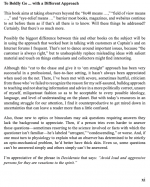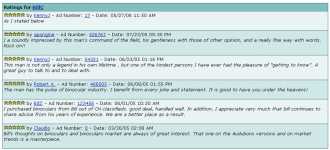You seem very immature and emotional for an old fella.
Your expertise is not in question, your attitude is. I'm not going to be bullied by you because you're an expert on binoculars.
Especially when 90% of your posts here and elsewhere are basically a sales pitch for your books.
If I'm breaking the rules of the forum, report me. If you're breaking the rules of the forum, stop it.
There is NO SECRET to the fact that for years I have encouraged people to come up with more modern techniques for performing the task. The Mk5 and the U.B.M.M. are just TOOLS. The KNOWLEDGE of the procedure should be enough to inspire inquisitive technicians for the benefit of so many.
“You seem very immature and emotional for an old fella.”
Let’s examine that.
“IMMATURE.” Right on! I went through maturity for about 2 weeks, in the 10th grade.
IT WASN’T FUN ... SO I QUIT!
“EMOTIONAL.” Right on, again! Of all the many anomalies observers like to bellyache over,
collimation is the
ONLY ONE observers could do anything about short of buying a new binocular. Because of that, I DO GET emotional when I consistently see a stream of people trying to pump their ego by coming up with some new ways to circumvent the science of 3-Axis Collimation ... but never do. This is why Zeiss, Leica, Swarovski, Nikon, and others follow the science. Even Vortex uses a U.B.M.M.
“Your expertise is not in question, your attitude is. I'm not going to be bullied by you because you're an expert on binoculars.”
That makes us even. With all due respect, I’m not going to be bullied by someone whose ego is head and shoulders are above his ability to reason. The first attachment is from that first book, and explains exactly why I do things the way I do. The more
“MATURE” observers understand and appreciate the effort and approach. Having been attacked for so long—by some, to whom thinking is not their strong suit—I started collecting attaboys from CN and BF. I could lay a hundred or so on you
(see attached). But your having disregarded quotes from Swarovski, Zeiss, Stephen Tonkin and others I can see it would be a waste of time in that honesty and accuracy apparently don’t fit into your AGENDA.
“When I first came to Cloudy Nights, I thought you were the biggest jerk in the world. Since then, I have read a lot and used several different binoculars and see you have been right about things straight down the line. You have taught me a lot and I thank you.”
— Mttafire
“Especially when 90% of your posts here and elsewhere are basically a sales pitch for your books.”
That statement is a BALD FACED LIE!!!!!!! PLEASE prove it or admit you were wrong.
With collimation being talked about so much and the would be experts being so wrong, I do my best to make others know of the books. From what I have seen lately, they wouldn’t hurt you, either.
But then, the third attachment will show the number of books I have sold so far in the month. I must be rolling in dough ... right?
(See attachment #3)
There is a little more to 3-Axis Collimation than having a jeweler’s screwdriver. You have drawn information from Oberwerk. Well, let me tell you a story about Oberwerk.
A Story: OM1 Cory Suddarth (S.O.R, Suddarth Optical Repair) worked with me aboard USS Grand Canyon and for me (OMC Cook) for about 7 years at Captain’s in Seattle. Knowing Kevin Busarow (owner of Oberwerk), we
TRIED to get him to understand the difference between binocular collimation (opto-mechanical) and Conditional Alignment (physiological, based on the observer’s level of spatial accommodation). When Kevin saw me ON CLOUDY NIGHTS trying to raise the bar of understanding, he apparently thought I was somehow trying to hurt his business and produced 2 videotapes for sale showing how conditional alignment was a “myth,” stating that he could,
“collimate a binocular to 100-power by eyeballing it.”
Kevin backed off a little when professors at the College of Optical Sciences at the University of Arizona and leaders of SPIE invited me to lecture on the subject at their 2012 San Diego convention.
But then, with Cory doing much of his repair and collimation work, he went to one of his
Collimation with a Mk 5 Collimator seminars and learned what we had been trying to tell him for over 15 years. After that, he purchased a Mk 5 collimator that I had sold to a company in southern California. Now he knows, “Conditional Alignment” isn’t a myth and is taking full advantage of the collimator that he “didn’t need.”
(see attachment 4)
Please give him a call and tell him what I said. First, he knows he was out of line and very WRONG in his comments—he didn’t understand about spatial accommodation. He also knows I have considered him a friend for years, and, if needed, I would give him the shirt off my back, and do anything I could to help him in his business. So, please, make a fool of yourself.
“You seem very immature and over-confident in your opto-ignorance and emotional for an old a young fella.”
Finally, I offer my hand, again. We have each said our peace. Can we now be friends?
If not, can we at least agree to disagree, agreeably?











